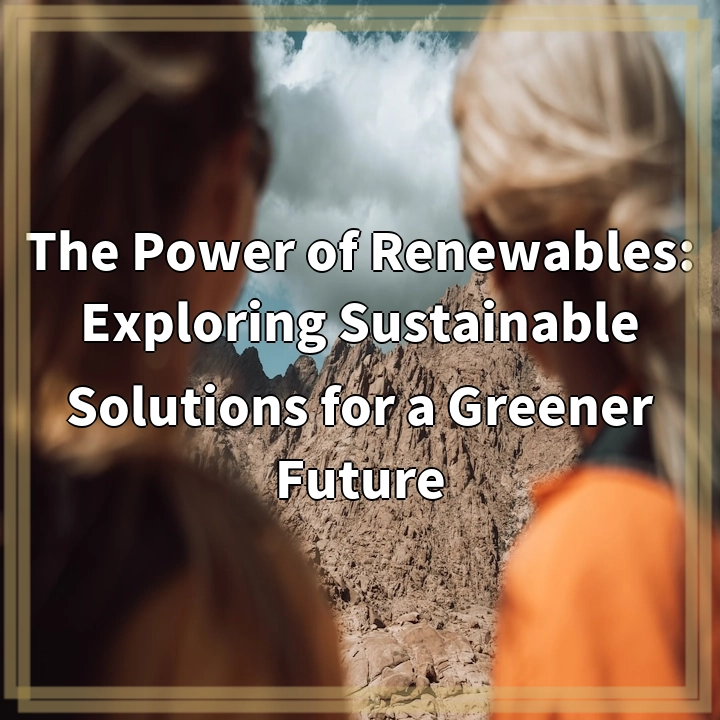
What is “The Power of Renewables: Exploring Sustainable Solutions for a Greener Future”
“The Power of Renewables: Exploring Sustainable Solutions for a Greener Future” is a blog post that delves into the significance of renewable energy sources in mitigating climate change and fostering a sustainable future. It explores various types of renewable energy technologies and their potential to revolutionize the way we generate power.
Real-World Problems
Despite the numerous benefits of renewable energy, there are several real-world problems associated with its wider adoption. Taking these problems into account is essential for a comprehensive understanding of the challenges and opportunities in transitioning to a greener future.
1. Intermittency and Energy Storage
One of the largest challenges faced by renewable energy sources is their intermittency. Unlike fossil fuel power plants that can generate consistent power, renewables like solar and wind are dependent on weather conditions. This intermittency poses challenges for energy grid stability. Additionally, the need for effective energy storage systems becomes vital to balance the intermittent supply and demand of renewable electricity.
2. Infrastructure and Grid Integration
The widespread adoption of renewable energy requires significant infrastructure development. Building new power plants, installing wind turbines or solar panels, and constructing transmission lines all demand substantial investments and careful planning. Furthermore, integrating renewable energy into existing power grids can be complex and costly due to differences in technical specifications and grid management practices.
3. Cost and Affordability
Although the cost of renewable energy technologies has decreased over the years, they still face challenges in terms of affordability compared to conventional fossil fuels. While the long-term benefits of clean energy justify the initial investment, the high upfront costs can be a barrier for widespread adoption, particularly in less economically developed regions.
4. Geographic Limitations and Resource Variability
Geographic limitations and resource variability can also pose challenges for renewable energy. For example, regions with low solar irradiation or limited wind resources may find it more challenging to harness the full potential of solar or wind power. This highlights the importance of customization and diversification of renewable energy sources based on the specific geographic and climatic conditions of each region.
5. Policy and Regulatory Frameworks
Successful integration and adoption of renewable energy technologies depend on supportive policy and regulatory frameworks. Inconsistent or inadequate policies can hinder investment in renewable energy projects, making it difficult to achieve widespread sustainable energy transition goals. It is crucial to establish clear and stable policies that encourage renewable energy adoption while addressing environmental, social, and economic concerns.
By recognizing and addressing these real-world problems associated with the power of renewables, we can strive for viable solutions and accelerate the transition towards a greener and more sustainable future.

Solutions for a Greener Future
Finding solutions to the real-world problems associated with the power of renewables is crucial to achieving a greener and more sustainable future. Here are some potential solutions that can help overcome the challenges identified in the previous section:
1. Advancements in Energy Storage
Developing more efficient and cost-effective energy storage technologies is essential for addressing the intermittency of renewable energy sources. Advancements in battery technologies, such as lithium-ion and flow batteries, along with innovative solutions like pumped hydro and compressed air energy storage, can help store excess renewable energy during peak production periods and release it during times of low generation.
2. Grid Modernization and Flexibility
Investing in grid modernization and flexibility is crucial for the successful integration of renewable energy. Upgrading the existing power grid infrastructure to accommodate bidirectional energy flow, implementing smart grid technologies, and adopting demand response programs can enhance grid stability and manage the intermittent nature of renewables more effectively.
3. Continued Research and Development
Continued research and development efforts are vital to drive innovation in renewable energy technologies. Investing in research to improve the efficiency and effectiveness of solar panels, wind turbines, and other renewable energy systems can help reduce costs, increase energy yields, and overcome geographic limitations and resource variability.
4. Financial Incentives and Subsidies
Governments and policymakers can play a significant role in promoting renewable energy adoption by implementing financial incentives and subsidies. Encouraging investment in renewable energy projects through tax credits, feed-in tariffs, and grants can help offset the upfront costs and make clean energy more affordable for consumers and businesses.
5. International Collaboration and Knowledge Sharing
Collaboration among countries, organizations, and researchers is essential to accelerate the global transition towards renewable energy. Sharing knowledge, best practices, and technology advancements can help overcome common challenges and facilitate the widespread adoption of renewable energy solutions worldwide.
By implementing these solutions and fostering a supportive environment, we can make significant progress in harnessing the power of renewables and building a more sustainable and greener future for generations to come.















